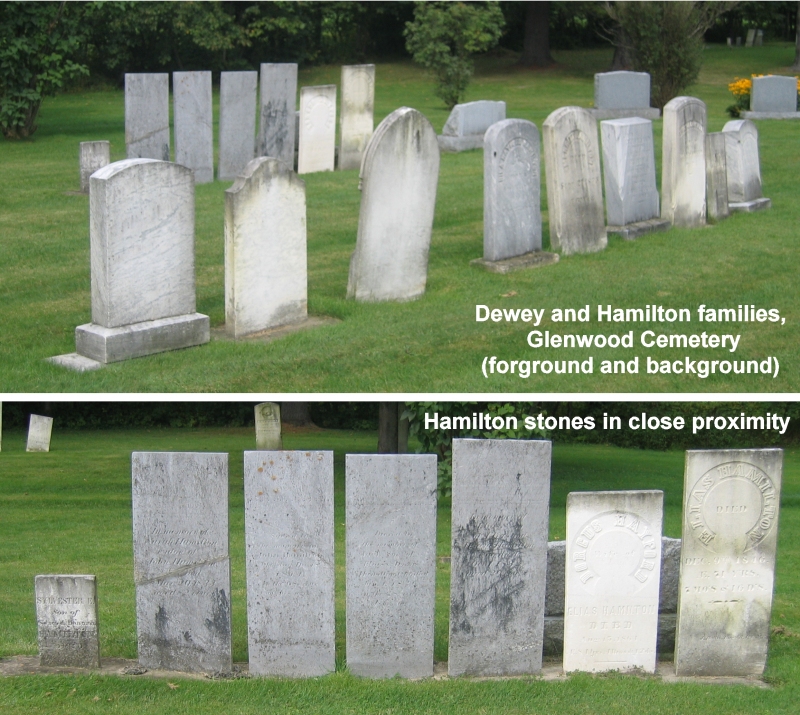The Dewey Family Cemetery
The Dewey family cemetery,
described to be about one acre in size, is south of the Dewey
house and across from the school. The cemetery likely
contains the remains of the Dewey, Hamilton, Odell, Newell,
Kingsley, Moore and Twiss families. American soldiers
serving in the War of 1812 who died after the LaColle stone mill
siege of March 1814 were buried here. Tradition states that
British soldiers who were wounded in the Battle of Plattsburgh
were cared for at the tavern, and when they died, they were buried
in the cemetery.
The cemetery was placed in the elevated area of
the south field in the sandy section. This location made it
easier to dig graves. Most of the corn field has rock ledge
below the surface and other areas of the field are low and flood
in the spring. Today, no trace of the Dewey family cemetery
exists and it is impossible to determine the exact location of the
main burials. Only the cemetery driveway over the ditch by
the road is present. Local legend states that the
cemetery stones were gradually removed over time by a farmer in
the early 1900s and some of them may have been thrown into the
newer part of the barn that burned down in 1973. No one
knows if this is true, though. Mr. Bedard says his father
remembered seeing the cemetery and that he only remembers seeing
the cemetery’s iron gate years later.
After many years of speculation, the date of
the removal of the cemetery stones has finally been narrowed
down. In October of 1935, Hugh McLellan transcribed the town
of Champlain cemeteries (some of which he noted were abandoned and
almost unreachable) but he never transcribed Dewey’s. This
is because the cemetery stones had already been moved to Glenwood
Cemetery. A 1936 newspaper article about the Dewey family
written by a descendent stated that no trace of the cemetery
remained. The author also said that only the iron gate
remained. The iron gate was removed between 1936 and
1961.
When Hugh completed the transcription of
Glenwood Cemetery, he recorded the stones from the Hamilton and
Dewey families. These stones had surely been in the Dewey
cemetery. Inspection of the two rows of stones show (left to
right): Sylvester Hamilton (son of Sidney and Hannah), Sarah
Hamilton (wife of John who died May 20, 1833, at the age of 82),
John Hamilton (who died on December 18, 1814 at age 68), Joel
Hamilton (son of Elias and Dorcas who died on January 4, 1826 at
the age of 28), Dorcas Hayford Hamilton, Elias Hamilton as well as
Silas Hamilton Dewey, Drucilla Dewey, Deacon Samuel Newell and
others.
The plot at Glenwood Cemetery was purchased by
Elizabeth Barber, daughter of Silas Hamilton Dewey, in 1909.
No Barbers or any of their descendents are buried in this plot
(they are buried in Riverside Cemetery in Plattsburgh).
Perhaps the stones were rescued by her after their removal from
the field. This is likely as the first half of the noted
Hamilton stones were placed in the same cement and spaced by only
a few inches. Most burial plots are larger than this.
The other half of the stones (such as Silas Hamilton Dewey, his
wife and sister Drusilla) were placed further apart so it is
possible burials could be here.

In any case, the stones of Elias, his wife
Lovisa and their youngest children have never been found.
Perhaps they did not have stones. Or perhaps their stones
were thrown into the foundation of the newer section of the barn
as several people today remember hearing this story. Again,
no one knows for sure. Further, the American and British
soldiers had been buried in “nameless graves” and did not have
stones. The location of their burials have been lost to
time. So it is likely that some or all of the Dewey and
Hamilton families (as noted) are still buried in the Dewey family
cemetery as well as all of the American and British
soldiers. A blue and yellow historic marker is planned for
this site in the coming years once funds are raised.
It should be noted that Deacon Samuel Newell
died on December 16, 1812, of “Camp Fever” (typhus) after being
exposed to American soldiers. He had married John Hamilton’s
daughter Elizabeth and lived on Lot 79. It was written that
a “fatal fever” had swept through the troops in early December and
by December 5, 27 soldiers had died in camp. At one time, 25
regular troops were sick as well as 84 militia and 140
inhabitants. Rev. Amos Pettingill, a traveling missionary
and the only minister available between Champlain and Plattsburgh,
consoled the sick and dying. Over four days, he wrote:
“visited 14 sick soldiers at my house, conversed with them and
prayed in three rooms.” “Visited the wounded, sick and
dying. 5 lay dead yesterday and 2 have left the world to
day.” “Visited the guard house; prayed with and
exhorted the soldiers. Spent considerable time in the
evening with the commanding officer, and three other
officers. Prayed with and solemnly exhorted them.”
“Heard of several who were siezed with sickness last night.
Visited an old Christian in great distress who is apparently near
death. Am unwell myself.” Pettingill would live
through this epidemic but 30 Champlainers died during the winter
including Deacon Newell.
